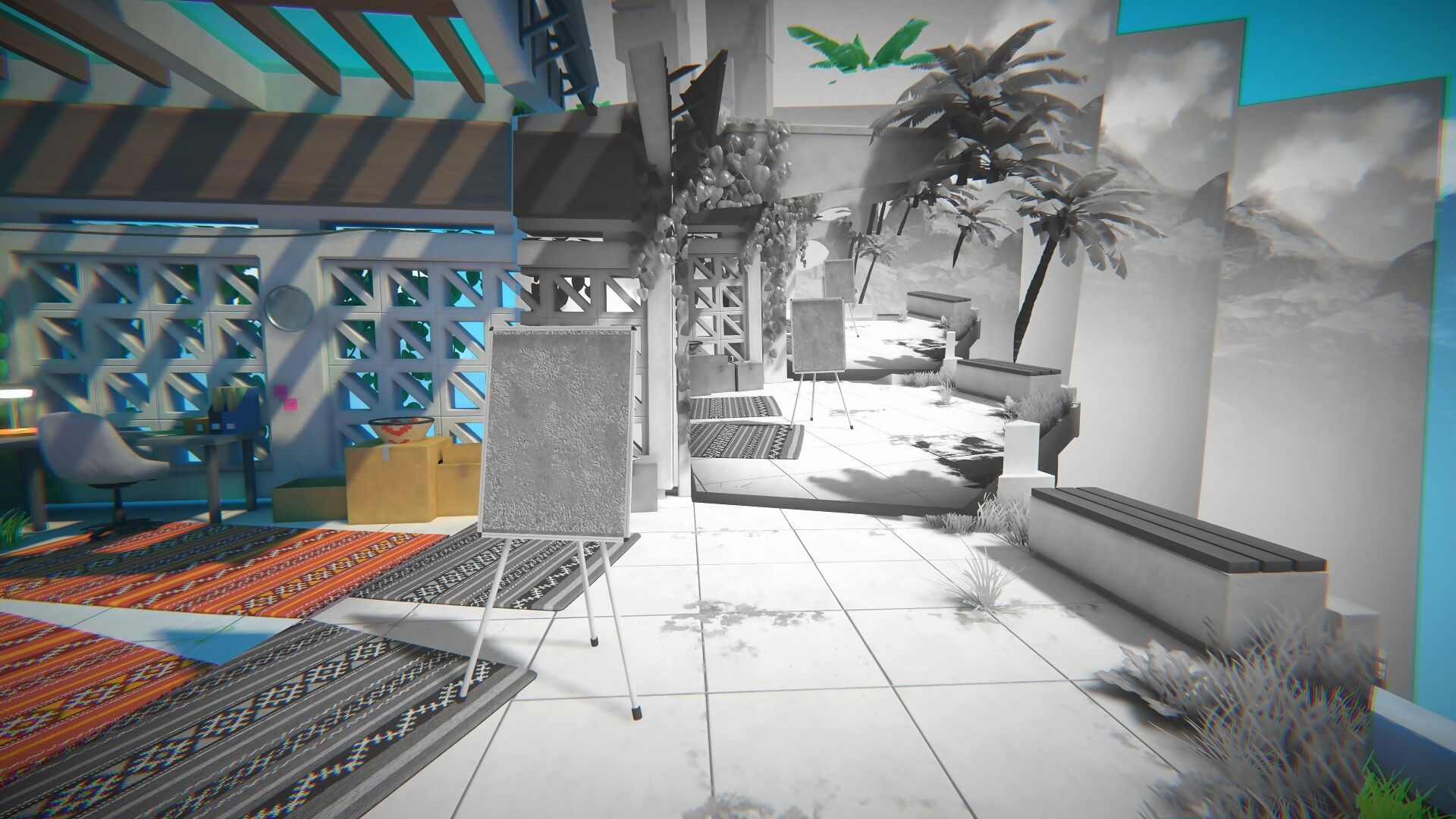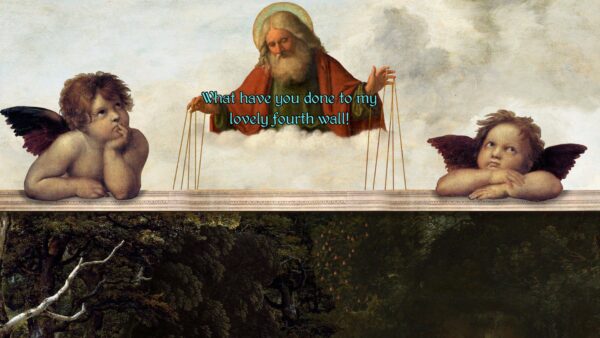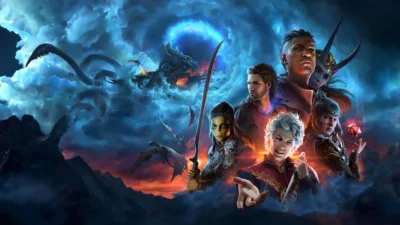
Viewfinder is shaping up to be 2023’s most absorbing and ingenious puzzler. We caught up with the developers behind its mind-boggling ideas.
Standing in what might be the grounds of an eerily serene hotel, or perhaps the stylish garden of an absent billionaire, I look around at the smooth rendered archways and little rows of ornamental grass. Then I remember the photo I have in my hand – a black and white image of a flight of stairs. I lift it up until the image of the stairs lines up with a high walkway some 30 feet in the distance, and press a button. In an instant, the contents of the photo take on a three-dimensional, physical form. I can then climb the stairs and get to the walkway that was previously far out of reach.
This is Viewfinder, the debut game from Sad Owl Studios, and what I’ve just hurriedly described is but one of dozens of mind-boggling, reality-distorting puzzles I encountered in my 30 to 40 minutes with it at London’s W.A.S.D expo in late March. In that time, I’ve conjured objects out of thin air, caused the sides of buildings to vanish, and walked into and explored an impressionist painting.
Full disclosure: I love games like Viewfinder. It’s the latest in a small but slowly growing genre that began (perhaps) with Portal, but soon took in the likes of Superliminal and Manifold Garden. These games and others like them do things that are impossible in any other medium: they can fool the eye and mess with our perceptions of 3D space. They can make us feel disoriented, even disturbed one moment, and leave us smiling at their ingenuity the next.
They’re video games as magic trick. Or they are, as Viewfinder’s game director Matt Stark calls them, “illusion games.”
“It’s probably not a big enough genre for anyone to put them into a category,” adds Jacob Keane, Viewfinder’s lead programmer. “People say,’Oh, it’s like Superliminal!’ because there isn’t a name for this genre. There’s so much potential for games in this space, but people don’t make them.”
Thankfully, Sad Owl Studios has made one. Viewfinder began life in 2019 when Stark was still at university. “I was working on various prototypes in my free time, sharing clips online,” Stark recalls, “and one of the ideas that I had was this camera game. It went viral, and so I decided to drop out of university to focus on developing it.”
No ordinary camera #madewithunity #shaders #gamedev #polaroid pic.twitter.com/b9YHboryME
— Matt Stark (@mattstark256) November 11, 2019
The clip Stark shared depicted an early version of Viewfinder’s most eye-catching mechanic. Armed with an instant camera, you can take a photograph of the environment, hold it up, then ‘bake’ the contents of the photo into the world. It’s such a complex-seeming, potentially game-breaking mechanic that I’d initially assumed the camera would only be available in certain areas, or work from specific angles.
Quite the opposite: it’s possible to use the camera however you see fit. You can take a picture of the sky, line up the resulting photo with the side of a building and magically erase part of the edifice from existence. You can do the same to the floor, leaving you plummeting into an endless blue void. So assuming that what we’re seeing isn’t witchcraft, how does it work?
“The short explanation is that, when you take a picture, it copies the whole environment, and it crops it by cutting meshes,” Stark says. “And then when you place a picture, it does a similar process in reverse: it chops a hole in the environment by changing a bunch of meshes again. But the devil’s in the details – it’s one thing to be able to cut meshes, it’s another to be able to do it with thousands of matches within a fraction of a second.”
Viewfinder’s photography mechanics are ingenious, but they’re complemented by the ability to press a button and rewind time, Braid style. It’s a play element that means you’re free to constantly experiment – so even if you accidentally chop the floor out from under your own feet, or erase a vital exit from existence, you can simply roll back your mistake and try again.

Photos can also be rotated before you ‘bake’ them into the landscape, resulting in surreal sights like this. Credit: Sad Owl Studios.
“Before Jacob joined the team, there wasn’t a rewind mechanic – there was just a button to restart the level,” Stark recalls. “And it was a massive pain, because if you did anything even slightly wrong, you had to reset the whole thing. But it was an interesting technical challenge.”
“It’s a challenge because you have to record anything that changes,” Keane adds. “It made all the code twice as complicated – and it’s already a very complicated game. But the payoff is entirely worth it… because it encourages the player to experiment. They can do silly things knowing they can undo it.”
The eerie stillness of Viewfinder’s environments is contrasted with the playful imagination in its design. At one stage, I find a photocopier, which lets me make multiple facsimiles of a photo of a battery I’ve picked up. This way, I can materialise multiple batteries, which I can then use to power an exit portal. In a brilliant touch, though, each photocopied battery looks more grainy and degraded than the last.

Viewfinder’s camera allows you to manipulate the environment, meaning even distant areas like this are still reachable. Credit: Sad Owl Studios.
There’s another point in the game where I walk through a series of images, each rendered in a different style. One second I’m exploring a world daubed in oils; the next I’m looking around at the shaky walls of a house drawn by a child. Then I’m exploring a woodblock print; then a PlayStation 1 era castle. It’s a captivating moment – all the more so because it feels like the work of a team exploring the creative boundaries of their own ideas.
“There are a bunch of parts in the game that are a technical flex,” Keane laughs. “Like, this should be impossible, and we’re doing it for the sake of it.”
“I’m certainly a massive show-off,” Stark concurs, pointing to another artistically mischievous moment in the game, presented at last year’s Game Awards. A copy of Edvard Munch’s painting The Scream appears on the screen. The painting is actually screaming. The player then makes multiple copies of the painting, resulting in a blood-curdling chorus of screams.
AHHHHHHHHHHHHH
AHHHHHHHHHHHHH
AHHHHHHHHHHHHH
[in unison] pic.twitter.com/F8mZ846P0z— SOS (@sadowlstudios) December 9, 2022
There’s a story to Viewfinder, too; we caught wisps of it during our time with the build and won’t spoil it here. “We can’t say too much about it,” says Stark. “The story explores themes of utopianism, friendship and sacrifice.”
There’s also an enigmatic, smiling cat that appears from time to time, like Alice in Wonderland.
It all brings us back to the notion of video games as a magic trick – or ‘illusion games’ as Stark calls them. Given just how surprising, witty and inventive they can be, why don’t we see more of them? “It’s difficult to make something interesting visually that also has a lot of depth in gameplay,” Stark observes. “It’s all very well coming up with a cool visual effect, but it also needs to work as a game.”
Viewfinder is undoubtedly more than a cool visual effect. From the time I’ve spent on it so far, it’s arguably the most absorbing, creative and – yes – magical puzzle game currently on the horizon.
Viewfinder is due for release on PC and PlayStation 5 in 2023.






1 Trackback or Pingback